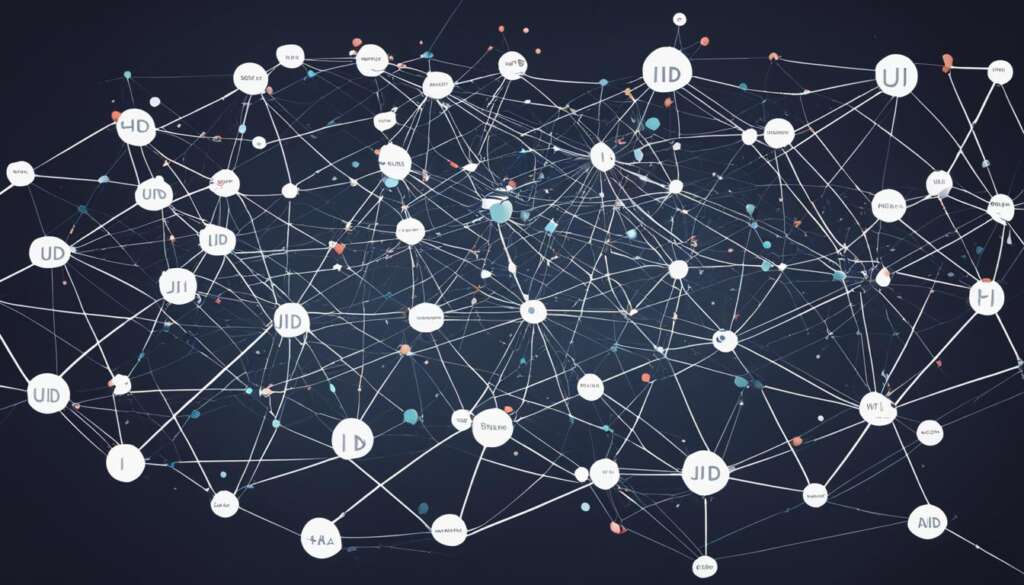Table of Contents
With the rise of digital identity, UID or Unique Identification has become a crucial aspect of identification and security systems. UID is essentially a numeric or alphanumeric code that provides a unique identity to an individual or entity. UID serves as a key component for accurate data management, authentication, access control, and privacy protection.
In this section, we will explore the meaning and significance of UID, its role in digital identity, and its importance in various sectors such as government, healthcare, and banking. Let’s dive in to understand what is UID and why it matters.
Key Takeaways
- UID or Unique Identification provides a unique identity code to an individual or entity.
- UID is a crucial component in accurate data management, authentication, access control, and privacy protection.
- UID plays a significant role in various sectors such as government, healthcare, and banking.
- Understanding UID is essential for navigating the evolving landscape of digital identity.
The Definition of UID
UID, short for Unique Identity, is a distinct identification number assigned to an individual or entity for the purposes of identification and verification. UID ensures that no two individuals or entities have the same identification number, making it an effective tool for identifying and tracking relevant entities across various sectors.
UID plays a vital role in diverse sectors such as healthcare, government, and banking, where precise identification and verification of individuals or entities are essential for seamless operations. UID is often used to streamline processes, enhance accuracy, and facilitate efficient data management.
UID is typically a combination of characters and numbers, with a specified length and format. It can be randomly assigned or generated using a range of identification systems. In some cases, biometric data is used to generate or link to a UID, ensuring enhanced accuracy and security.
UID in Identification Systems
UID, or Unique Identification, is a critical component of modern identification systems, streamlining processes, enhancing accuracy, and facilitating efficient data management across various sectors. UID serves as a unique identifier for individuals or entities, enabling accurate and secure data collection, storage, and retrieval.
In government, UID plays a crucial role in enabling efficient administration and service delivery, eliminating duplicate entries, and enabling targeted welfare schemes. In healthcare, UID helps in maintaining accurate electronic health records, ensuring personalized and timely treatment, and reducing medical errors.
In banking and finance, UID serves as a secure identifier for users, enabling hassle-free access to credit and other financial services. Additionally, UID helps prevent fraud, money laundering, and cybercrime, thereby enhancing the overall security of the banking system.
“UID revolutionised the way we do identification in India, bringing transparency, efficiency, and convenience to the identification process”.
UID has witnessed significant adoption worldwide, with countries such as India and Malaysia leading the way in implementing national identification systems based on UID. As a result, UID has become a critical tool in today’s digital age, underlining its role in facilitating secure and efficient identification and data management systems.
UID and Security
UID plays a substantial role in ensuring secure and reliable operations in various sectors by providing effective authentication, access control, and data protection measures.
Authentication is a vital component in verifying a user’s identity. UID enables secure authentication processes by providing a unique identification that cannot be replicated, ensuring that the right people have access to the right information or systems.
Access control is another essential component of security that UID helps facilitate. UID ensures that access to confidential information is only granted to authorized individuals or entities and that sensitive data is not compromised.
| Type of Protection | Description |
|---|---|
| Data encryption | Protecting data by converting it into an unreadable format that can only be accessed with a decryption key. |
| Firewalls | A protective barrier that blocks unauthorized access while allowing necessary communication. |
| Intrusion Detection and Prevention Systems | Automated security mechanisms that monitor and analyze network traffic for potential malicious activity. |
| Security Information and Event Management (SIEM) | A centralized platform that manages security events and incidents, providing real-time visibility into network activity. |
Data protection is crucial, especially in sectors such as finance, healthcare, and government. UID ensures data protection by implementing security measures such as data encryption, firewalls, intrusion detection and prevention systems, and security information and event management (SIEM).
However, there are potential risks associated with UID. For example, cyber attackers may attempt to steal or compromise UID data, leading to security breaches and identity theft. Additionally, there may be concerns surrounding privacy issues and the collection and use of personal information. It is vital to address these risks and concerns proactively to ensure the secure and ethical use of UID.
UID in the Digital Age
As we move further into the digital age, UID plays an increasingly vital role in shaping the way we interact with technology. Emerging technologies such as biometrics, blockchain, and artificial intelligence are transforming the way we use and share data, and UID is at the forefront of this transformation.
UID has become a critical component for individuals and organizations operating in the digital realm. It enables secure access and authentication, facilitates data management, and helps identify users across various platforms.
| Technology | Impact on UID |
|---|---|
| Biometrics | Advances in biometrics have enabled a shift away from traditional authentication methods towards biometric-based UID systems. Biometric identifiers such as fingerprint scans, facial recognition, and iris scans are increasingly being used to uniquely identify individuals. |
| Blockchain | Blockchain technology offers a decentralized, tamper-proof database. UID can be stored within the blockchain, making it more secure and accessible. |
| Artificial Intelligence | AI helps to analyze large amounts of UID data and detect potential security breaches or anomalies. Machine learning algorithms can also help improve the accuracy of UID systems. |
However, the integration of UID with these technologies raises concerns around data privacy and governance. As more data is collected and shared, it becomes increasingly important to establish effective policies and procedures for data protection.
Conclusion
In conclusion, it is evident that UID plays a crucial role in today’s digital age. By uniquely identifying individuals or entities, UID helps streamline operations and enhance efficiency in various sectors such as government, healthcare, and banking. Its role in identification and security cannot be overemphasized, as it ensures authentication, access control, and data protection.
However, the implementation of UID comes with potential risks and challenges that must be addressed. It is crucial to strike a balance between security and privacy to avoid compromising sensitive information continually.
As emerging technologies such as biometrics, blockchain, and artificial intelligence continue to gain traction, the relevance of UID will only increase. It is essential to keep up with the evolving landscape of digital identity by understanding the fundamental concepts of UID and their implications.
With this knowledge, individuals and organizations can navigate the digital age confidently and take advantage of the benefits provided by UID. Thank you for reading.
FAQ
What is UID?
UID stands for Unique Identification. It is a system used to uniquely identify individuals or entities in various sectors.
How is UID used in identification systems?
UID plays a critical role in modern identification systems by streamlining processes, enhancing accuracy, and facilitating efficient data management in sectors such as government, healthcare, and banking.
What is the relationship between UID and security?
UID is crucial for ensuring authentication, access control, and data protection. It helps establish a secure framework in which individuals or entities can be identified and their information can be safeguarded.
How does UID integrate with emerging technologies in the digital age?
UID integrates with technologies such as biometrics, blockchain, and artificial intelligence, enabling more advanced and secure methods of identification and data management. However, it also raises considerations around privacy and data governance.
Why is understanding UID important in today’s digital age?
Understanding UID is essential for navigating the evolving landscape of digital identity. It is a fundamental component in identification and security systems that enable efficient and secure operations across various sectors.













